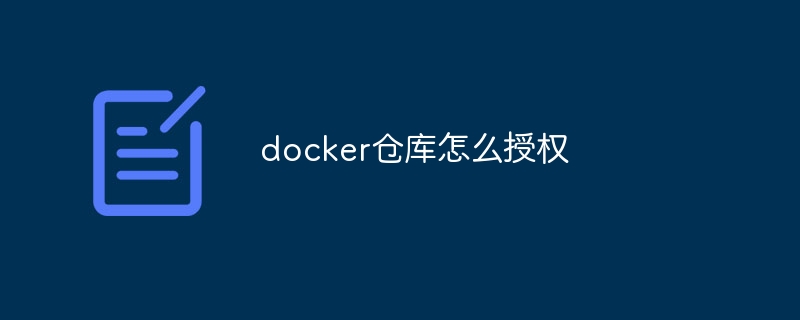How to authorize a docker repository
Docker repository authorization can be implemented through the ACL of Docker Hub or custom authentication. ACL allows specifying access to users or teams, while custom authentication provides finer granular control, such as username/password, token, or SSO. Authorized permissions include read, write, and administrative access, and should be assigned based on user type, mirror sensitivity, and required management levels.

Docker repository authorization
How to authorize a Docker repository?
Authorizing a Docker repository involves granting users permissions to access and manage repository. This can be done by using the Docker Hub's access control list (ACL) or setting up custom authentication.
Docker Hub ACL
Docker Hub provides an ACL system that allows you to specify specific user and team permissions for your repository. To use ACL:
- Log in to Docker Hub.
- Navigate to your warehouse.
- Click the Settings tab.
- In the Access Control section, add users or teams and assign them the permissions they need.
Custom authentication
If you want more fine-grained control, you can set up custom authentication, for example:
- Username/password authentication: Use traditional username and password for authentication.
- Token Authentication: Use an authorization token to authenticate.
- Single Sign-On (SSO): Authenticate using an external identity provider.
To set up custom authentication, you need to use the Docker API or the Docker Registry v2 API. For more information, see the official Docker documentation.
Specific permissions
Docker repository permissions can be divided into the following levels:
- Read access: Allows the user to pull the image.
- Write access permission: Allows users to push images.
- Administrative access: Allows users to manage repositories, such as adding and deleting users.
The following factors should be considered when assigning permissions:
- The type of user that needs to access the repository.
- Sensitivity of mirroring in warehouses.
- The level of management required.
By carefully managing authorization for Docker repositories, you can ensure that only the appropriate users can access and operate your images.
The above is the detailed content of How to authorize a docker repository. For more information, please follow other related articles on the PHP Chinese website!

Hot AI Tools

Undresser.AI Undress
AI-powered app for creating realistic nude photos

AI Clothes Remover
Online AI tool for removing clothes from photos.

Undress AI Tool
Undress images for free

Clothoff.io
AI clothes remover

Video Face Swap
Swap faces in any video effortlessly with our completely free AI face swap tool!

Hot Article

Hot Tools

Notepad++7.3.1
Easy-to-use and free code editor

SublimeText3 Chinese version
Chinese version, very easy to use

Zend Studio 13.0.1
Powerful PHP integrated development environment

Dreamweaver CS6
Visual web development tools

SublimeText3 Mac version
God-level code editing software (SublimeText3)

Hot Topics
 How to exit the container by docker
Apr 15, 2025 pm 12:15 PM
How to exit the container by docker
Apr 15, 2025 pm 12:15 PM
Four ways to exit Docker container: Use Ctrl D in the container terminal Enter exit command in the container terminal Use docker stop <container_name> Command Use docker kill <container_name> command in the host terminal (force exit)
 How to copy files in docker to outside
Apr 15, 2025 pm 12:12 PM
How to copy files in docker to outside
Apr 15, 2025 pm 12:12 PM
Methods for copying files to external hosts in Docker: Use the docker cp command: Execute docker cp [Options] <Container Path> <Host Path>. Using data volumes: Create a directory on the host, and use the -v parameter to mount the directory into the container when creating the container to achieve bidirectional file synchronization.
 How to check the name of the docker container
Apr 15, 2025 pm 12:21 PM
How to check the name of the docker container
Apr 15, 2025 pm 12:21 PM
You can query the Docker container name by following the steps: List all containers (docker ps). Filter the container list (using the grep command). Gets the container name (located in the "NAMES" column).
 How to restart docker
Apr 15, 2025 pm 12:06 PM
How to restart docker
Apr 15, 2025 pm 12:06 PM
How to restart the Docker container: get the container ID (docker ps); stop the container (docker stop <container_id>); start the container (docker start <container_id>); verify that the restart is successful (docker ps). Other methods: Docker Compose (docker-compose restart) or Docker API (see Docker documentation).
 How to start mysql by docker
Apr 15, 2025 pm 12:09 PM
How to start mysql by docker
Apr 15, 2025 pm 12:09 PM
The process of starting MySQL in Docker consists of the following steps: Pull the MySQL image to create and start the container, set the root user password, and map the port verification connection Create the database and the user grants all permissions to the database
 How to update the image of docker
Apr 15, 2025 pm 12:03 PM
How to update the image of docker
Apr 15, 2025 pm 12:03 PM
The steps to update a Docker image are as follows: Pull the latest image tag New image Delete the old image for a specific tag (optional) Restart the container (if needed)
 How to view the docker process
Apr 15, 2025 am 11:48 AM
How to view the docker process
Apr 15, 2025 am 11:48 AM
Docker process viewing method: 1. Docker CLI command: docker ps; 2. Systemd CLI command: systemctl status docker; 3. Docker Compose CLI command: docker-compose ps; 4. Process Explorer (Windows); 5. /proc directory (Linux).
 How to change the docker image source in China
Apr 15, 2025 am 11:30 AM
How to change the docker image source in China
Apr 15, 2025 am 11:30 AM
You can switch to the domestic mirror source. The steps are as follows: 1. Edit the configuration file /etc/docker/daemon.json and add the mirror source address; 2. After saving and exiting, restart the Docker service sudo systemctl restart docker to improve the image download speed and stability.






